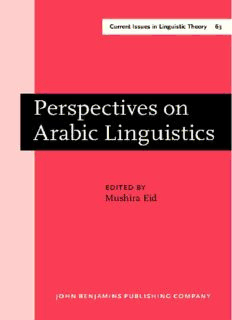
Perspectives on Arabic Linguistics: Papers from the Annual Symposium on Arabic Linguistics. Volume I: Salt Lake City, Utah 1987 PDF
Preview Perspectives on Arabic Linguistics: Papers from the Annual Symposium on Arabic Linguistics. Volume I: Salt Lake City, Utah 1987
PERSPECTIVES ON ARABIC LINGUISTICS I AMSTERDAM STUDIES IN THE THEORY AND HISTORY OF LINGUISTIC SCIENCE General Editor E.F. KONRAD KOERNER (University of Ottawa) Series IV - CURRENT ISSUES IN LINGUISTIC THEORY Advisory Editorial Board Henning Andersen (Los Angeles); Raimo Anttila (Los Angeles) Thomas V. Gamkrelidze (Tbilisi); Hans-Heinrich Lieb (Berlin) J. Peter Maher (Chicago); Ernst Pulgram (Ann Arbor, Mich.) E. Wyn Roberts (Vancouver, B.C.); Danny Steinberg (Tokyo) Volume 63 Mushira Eid (ed.) Perspectives on Arabic Linguistics I PERSPECTIVES ON ARABIC LINGUISTICS I PAPERS FROM THE FIRST ANNUAL SYMPOSIUM ON ARABIC LINGUISTICS Edited by MUSHIRA EID University of Utah Salt Lake City JOHN BENJAMINS PUBLISHING COMPANY AMSTERDAM/PHILADELPHIA 1990 Library of Congress Cataloging-in-Publication Data Symposium on Arabic Linguistics (1st : 1987 : University of Utah) Perspectives on Arabic linguistics I : papers from the First Annual Symposium on Arabic Linguistics / edited by Mushira Eid. p. cm. -- (Amsterdam studies in the theory and history of linguistic science. Series IV, Current issues in linguistic theory, ISSN 0304-0763; v. 63) Papers from a symposium held Apr. 24-25, 1987 at the University of Utah. Includes bibliographical references and index. 1. Arabic language--Grammar--Congresses. 2. Arabic language--Semantics--Congres- ses. I. Eid. Mushira. II. Title. III. Title: Perspectives on Arabic linguistics 1. IV. Title: Perspectives on Arabic linguistics one. PJ6106.S9884 1987 492'.75--dc20 90-959 ISBN 90 272 3560 0 (alk. paper) CIP © Copyright 1990 - John Benjamins B.V. No part of this book may be reproduced in any form, by print, photoprint, microfilm, or any other means, without written permission from the publisher. To Gerald Sanders, Teacher and Friend Table of Contents Preface ix I. Overview Arabic Linguistics: The Current Scene 3 Mushira Eid "Come Forth with a Surah Like It": Arabic as a Measure of Arab Society 39 Charles Ferguson II. Grammatical Perspectives Sound Plural and Broken Plural Assignment in Classical Arabic 55 Mohamad Z. Abd-Rabbo The Problem of Subject-Verb Agreement in Arabic: Towards a Solution 95 M.A. Mohammad Word Order and Proper Government in Classical Arabic 127 Basim Majdi Bound Anaphora in Egyptian Arabic 155 Mariam H. Osman Time Reference, Tense, and Formal Aspect in Cairene Arabic 173 John Eisele III. Textual Analysis Perspectives 'Orality' and Discourse Structure in Modern Standard Arabic 215 Barbara Johnstone Loss of Nominal Case Endings in the Modern Arabic Dialects: Evidence from Southern Palestinian Christian Middle Arabic Texts 235 Ann M. Gruber-Miller viii TABLE OF CONTENTS IV. Psycholinguistic Perspectives Bilingual Linguistic Memory 257 Shadia A. Tel Slips of the Tongue in Arabic 271 Sabah Safi-Stagni Index of Subjects 291 Preface The papers in this volume, with the exception of two (Eid and Safi), have been selected from the First Annual Symposium on Arabic Linguistics held at the University of Utah, April 24-25,1987. The purpose of the symposium was to provide a forum for scholars interested in current linguistic approaches to the study of Arabic. To my knowledge, this has been the first event of its kind in the US. The symposium was initially planned to be an annual event; and in view of the success that the first symposium has had, the original plans have been implemented with the Second Annual Sym posium held in 1988 and the Third Annual Symposium being planned for 1989. The motivation for starting an annual symposium has come from two sources: first, the realization on my part and on the part of other linguists of how much Arabic has to offer to the general linguist and how much insight current approaches to linguistics can offer to all aspects of the study of the Arabic language; and second, the realization that a large body of research has been done in recent years on Arabic but that researchers in this field have little or no chance to meet and focus their discussion on Arabic. These annual symposiums, then, have been planned to fill in this gap and to pro mote further interest and research in Arabic linguistics. The purpose of this book, then, is to disseminate research on Arabic from various areas of current linguistics to as wide an audience as possible. By not restricting the scope of the book to any one area of linguistics or its related fields, it is hoped that the book will provide a more general perspec tive on aspects of Arabic in relation to various areas of linguistics and that it will be a source of information for both the general linguist and the Arabic linguist alike. To the general linguist, it will provide information and data on Arabic analyzed within current models of analysis; to the Arabic linguist, it will provide, in addition, current analyses of at times familiar data, at other times data not so familiar. The book is divided into three sections, each providing one or more
Description: